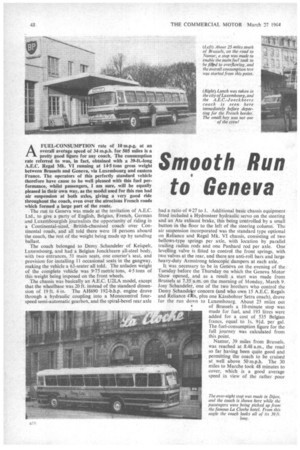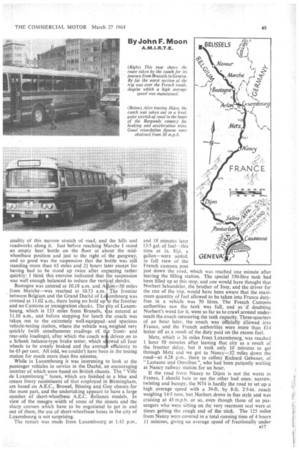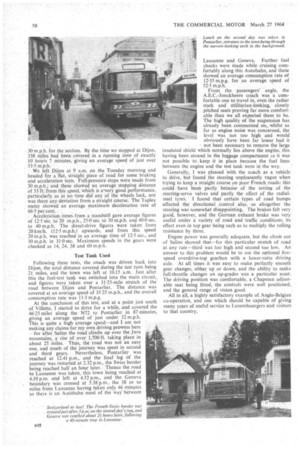Smpoth Run to Geneva
Page 50

Page 51

Page 52

If you've noticed an error in this article please click here to report it so we can fix it.
AFUEL-CONSUMPTION rate of 10 m.p.g. at an overall average speed of 34 m.p.h. for 505 miles is a pretty good figure for any coach. The consumption rate referred to was, in fact, obtained with a 39-ft.-long A.E.C. Regal Mk. VI running at 14.5 tons gross weight between Brussels and Geneva, via Luxembourg and eastern France. The operators of this perfectly standard vehicle therefore have cause to be well pleased with this fuel performance, whilst passengers, I am sure, will be equally pleased in their own way, as the model used for this run had air suspension at both axles, giving a very good ride throughout the coach, even over the atrocious French roads which formed a large part of the route.
The run to Geneva was made at the invitation of A.E.C. Ltd., to give a party of English, Belgian, French, German and Luxembourgish journalists the opportunity of riding in a Continental-sized, British-chassised coach over Continental roads, and all told there were 18 persons aboard the coach, the rest of the weight being made up by sandbag ballast. The coach belonged to Demy Schandeler of KeiSpelt, Luxembourg, and had a Belgian Jonckheere all-steel body, with two entrances, 51 main seats, one courier's seat, and provision for installing 11 occasional seats in the gangway, making the vehicle a 63-seater all told. The unladen weight of the complete vehicle was 9-75 metric tons, 4.5 tons of this weight being imposed on the front wheels. The chassis was basically an A.E.C. U2LA model, except that the wheelbase was 20 ft. instead of the standard dimension of 19 ft. 6 in. The AH690 192-b.h.p. engine drove through a hydraulic coupling into a Monocontrol fourspeed semi-automatic gearbox, and the spiral-bevel rear axle
had a ratio of 4-27 to 1. Additional basic chassis equipment fitted included a Hydrosteer hydraulic servo on the steering and an Ate exhaust brake, this being controlled by a small button in the floor to the left of the steering column. The air suspension incorporated was the standard type optional on Reliance and Regal Mk. VI chassis, consisting of two bellows-type springs per axle, with location by parallel trailing radius rods and one Panhard rod per axle. One levelling valve is fitted to control the front springs, with two valves at the rear, and there are anti-roll bars and large heavy-duty Armstrong telescopic dampers at each axle.
It was necessary to be in Geneva on the evening of the Tuesday before the Thursday on which the Geneva Motor Show opened, and as a result a start was made from Brussels at 7.35 a.m. on the morning of Monday, March 9. Josy Schandeler, one of the two brothers who control the Demy SchandelFr concern (and who own 15 A.E.C. Regals and Reliance 4s, plus one Kassbohrer Setra coach), drove for the run down to Luxembourg. About 25 miles out
• of Brussels a 10-minute stop was made for fuel, and 193 litres were added for a cost of 535 Belgian francs, equal to Is. 9-}d. per gal. The fuel-consumption figure for the full journey was calculated from this point.
Namur, 39 miles from Brussels. was reached at 8.48 a.m., the road so far having been quite good and permitting the coach to be cruised at well above 50 m.p.h. The 30 miles to Marche took 48 minutes to cover, which is a good average speed in view of the rather poor
quality of this narrow stretch of road, and the hills and roadworks along it. Just before reaching Marche I stood an empty beer bottle on the floor at about the midwheelbase position and just to the right of the gangway, and so good was the suspension that the bottle was still standing more than 65 miles and 24 hours later except for having had to be stood up twice after comering rather quickly: I think this exercise indicated that the suspension was well enough balanced to reduce the vertical shocks. Bastogne was entered at 10.18 a.m. and Allon=50 miles from Marche—was reached at 10.53 a.m. The frontier between Belgium and the Grand Duch. of Lutembourg was crossed at 11.02 a.m., there being no hold up 'at the frontier and no Customs or immigration checks. The lity of Luxembourg, which is 133 miles from Brussels, tas entered at 11.16 a.m., and before stopping for lunch the coach was taken out to the extremely well-equipped and spacious vehicle-testing station, where the vehicle wa% weighed very quickly (with simultaneous readings of t e frontand rear-axle loadings), after which the coach w. driven on to a Schenk balance-type brake tester, which s wed all four wheels to be evenly braked and the avera efficiency to be 65 per cent. All told, we couldn't have been in the testing station for much more than five minutes.
While in Luxembourg it was interesting to look at the passenger vehicles in service in the Duch, an encouraging number of which were based on British chassis. The "Ville de Luxembourg" buses, which are finished in a blue and cream livery reminiscent of that employed in Birmingham, are based on A.E.C., Brossel, Bussing and, Guy chassis for the most part, and the undertaking appears to have a large number of short-wheelbase A.E.C. Reliance models. In view of the meagre width of some of the streets and the sharp corners which have to be negotiated to get in and out of them, the use of short-wheelbase buses in the city of Luxembourg is not surprising.
The restart was made from Luxembourg at 1.43 p.m.,
and 18 minutes later 13.5 gal. of fuel--this time at Is. 8;d. a gallon—were added, in full view of the French customs post just down the road, which was reached one minute after leaving the filling station. The special 350-litre tank had been filled up at this stop, and one would have thought that Norbert Schandeler, the brother of limy, and the driver for the rest of the trip, would have been aware that the maximum quantity of fuel allowed to be taken into France dutyfree in a vehicle was 70 litres. The French Customs authorities saw the tank was full, and as if doubting Norbert's word for it, went so far as to crawl around underneath the coach measuring the tank capacity. Three-quarters of an hour later, the coach was officially allowed into France, and the French authorities were more. than £14 better off as a result of the duty paid on the excess fuel.
Metz, which is 36 miles from•Lnxembourg, was reached 1 hour 50 minutes after leaving that city as a result of the frontier delay, but it took only 10 minutes to get through Metz and we got to Nancy-3/ miles down the road—at 4.28 p.m., there to collect Richard Gebauer, of
Lastauto und Omnibus " who had been patiently waiting at Nancy railway station ior an hour.
If the road from Nancy to Dijon is not the worst in France, I should hate to see the other bad ones: narrow, twisting and bumpy, the N74 is hardly the road to set up a high average speed with a. 39-ft. by 8-ft. 2-5,in. coach weighing 14.5 tons, but Norbert drove in fine style and was cruising at 45 m.p.h. or so, even though those of us passengers who were sitting on the very rearmost seat were at times getting the rough end of the stick. The 125 miles from Nancy were covered in a total running time of 4 hours II minutes, giving an average speed of fractionally under
30 m.p.k for the section. By the time we stopped at Dijon, 338 miles had been covered in a running time of exactly 10 hours 7 minutes, giving an average speed of just over 33.5 m.p.h. '
We left Dijon at 9 a.m. on the Tuesday morning and headed for a flat, straight piece of road for some braking and acceleration tests. Full-pressure stops were made from 30 m.p.h., and these showed an average stopping distance of 53 ft. from this speed, which is a'very good performance, particularly as at no time did any of the wheels lock, nor was there any deviation from a straight course. The Tapley meter showed an average maximum deceleration rate of 66.5 percent. Acceleration times from a standstill gave average figures of 12.5 sec. to 20 m.p.h., 25.0 sec. to 30 m.p.h. and 40-0 sec. to 40 m.p.h. The direct-drive figures were taken from 20 km/h. (12.5 m.p.h.) upwards, and from this speed 20 m.p.h. was reached in an average time of 12.5 sec., and 30 m.p.h. in 31.0 sec. Maximum speeds in the gears were checked as 14, 24, 38 and 60 m.p.h.
Test Tank Used Following these tests, the coach was driven back into Dijon, the total distance covered during the test runs being 21 miles, and the town was left at 10.15 a.m. Just after this the fuel-test tank was switched into the main circuit, and figures were taken over a 31:25-mile stretch of the road between Dijon and Pontarlier. The distance was covered at an average speed of 35.25 m.p.h., and the overall consumption rate was 11.3 m.p.g.
At the conclusion of this test, and at a point just south of Villette, I started to 'drive for a while, and covered the 46-25 miles along the N72 to Pontarlier in 87 minutes, giving an average speed of just under 32 m.p.h. This is quite a high average speed--and I am not making any claims for my own driving prowess here for after Satins the road climbs up over the Jura mountains, a rise of over 1,700 ft. taking place in about 25 miles. Thus, the road was not an easy one, and much of the journey was spent in second and third gears. Nevertheless, Pontarlier was reached at 12.41 p.m., and the final leg Of the journey was restarted at 2.32 p.m., the Swiss border being reached half an hour later. Thence the road to Lausanne was taken, this town being reached at 4.10 p.m. and left at 4.52 p.m., and the Geneva boundary was crossed at 5.38 p.m., the 38 or so miles from .Lausanne haying taken only 46 minutes 'as there is an Autobahn most of the way. between
Lausanne and Geneva. Further fuel checks were made while cruising comfortably along this Autobahn, and these showed an average consumption rate of 12.35 m.p.g. for an average speed of 52.5 m.p.h.
From the passengers' angle, the A.E.C.-Jonckheere coach was a comfortable one to travel in, even the rather stark and utilitarian-looking, closely pitched seats proving far more comfortable than we all expected them to be. The high quality of the suspension has already been commented on, whilst so far as engine noise was concerned, the level was not too high and would obviously have been far lower had it not been necessary to remove the large insulated shield which normally lies above the engine, this having been. stowed_ in the luggage compartment as it was not possible tokeep it in place because the fuel lines between the engine and the test tank were in the way.
Generally, I was pleased with the coach as a vehicle to drive, but found the steering unpleasantly vague when trying to keep a straight course on poor French roads: this could have been partly because of the setting of the steering-servo valves and partly the effect of the radialsteel tyres. I found that certain types of road bumps affected the directional .control also, so altogether the steering was somewhat disappointing. The brakes felt very good, however, and the German exhaust brake was very useful under a variety of road and traffic conditions, its effect even in top gear being such as to multiply the rolling resistance by three.
Engine power was generally adequate, but the climb out of Salins showed that—for this particular stretch of road at any rate—third was too high and second too low. An answer to this problem would be to use the optional fivespeed overdrive-top gearbox with a lower-ratio driving axle. At all times it was easy to make perfectly smooth gear changes, either up or down, and the ability to make full-throttle changes on up-grades was a particular asset. The driving position was comfortable, a Chapman adjustable seat being fitted, the controls were well positioned, • and the general range of vision good.
All in all, a highly satisfactory example of Anglo-Belgian co-operation, and one which should be capable of giving many years of useful service to Luxembourgers and visitors to that country.




































































































